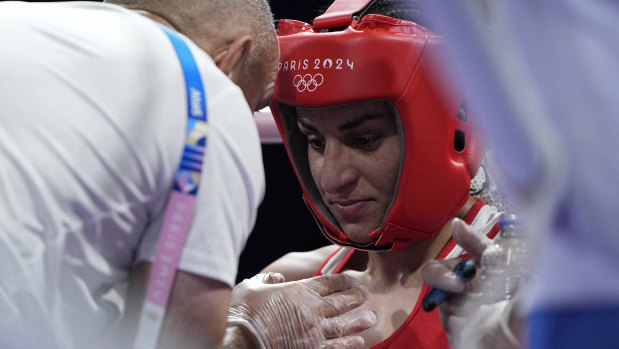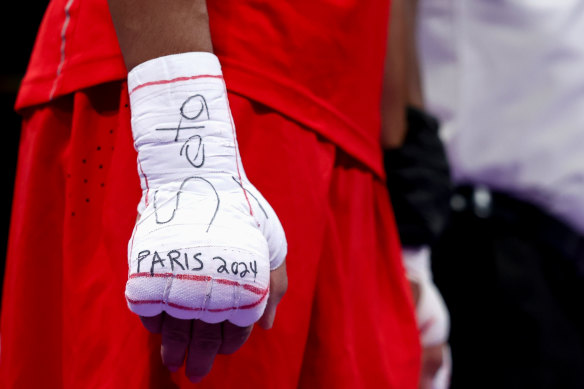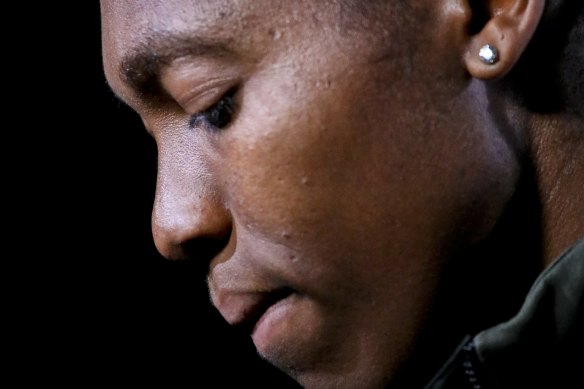- Analysis
- National
- Paris 2024
This was published 10 months ago
Not so simple: Boxer Imane Khelif and the science of sex
By Liam Mannix
Examine, a free weekly newsletter covering science with a sceptical, evidence-based eye, is sent every Tuesday. You’re reading an excerpt – sign up to get the whole newsletter in your inbox.
The world’s media has spent the past few days speculating about Algerian boxer Imane Khelif’s sex. Khelif was previously disqualified by the International Boxing Association (IBA) after taking what was first described as a mysterious “gender eligibility test”. The International Olympic Committee last year stripped the IBA of its status as boxing’s governing body. Khelif now looks likely to win a medal in Paris. “I am a female,” she said after her latest victory.

“I am female”: Algeria’s Imane Khelif between rounds against Hungary’s Anna Hamori in their women’s 66-kilogram quarter-final boxing match at the Paris Olympics at the weekend.Credit: AP
Before we dive into this, let’s start by agreeing that speculating about a person’s sex based entirely on media reporting is gross.
To me, two key points emerge from the scientific literature.
First, humans exhibit a wide variety of differences in sexual development. There is no simple binary.
Second, a history of women playing sports is also a history of successful female athletes being subject to questions about their sex – particularly women of colour.
The basic biology
At school, we are taught that females have XX chromosomes and males XY. This leads us to a place where we think the differences between men and women are obvious and irrefutable.
The science tells an entirely different story. First, while relatively rare, humans can be born with a range of different chromosomes, including XXY and XO.
Our chromosomes do not conclusively determine our sex. For example, in some cases the X and Y chromosomes can recombine, leading to a child with XX chromosomes and male sexual attributes.
Indeed, the region on the Y chromosome that determines the development of male testes is located perilously close to the region the chromosome divides – leading humans as a species to have a “relatively high frequency of sex reversal”.
“Humans aren’t black and white; they’re not just male and female,” says Associate Professor Ada Cheung, endocrinologist at the University of Melbourne. “There are many ways to be intersex.”
Nor does a single gene determine sex. The human fetus develops a “bipotential gonad”, which is then shaped by the actions of a large number of genes. Alterations to each of those genes can cause differences in sexual development. Variations in more than 70 genes have been linked to differences in sexual development.
On top of this sit hormones, chemical messengers like testosterone, that the developing foetus produces and which trigger changes in genital development.
Consider androgen insensitivity syndrome: the individual has XY chromosomes but their body cannot respond to certain male sex hormones. Or congenital adrenal hyperplasia, where alterations to a key gene lead to excess male sex hormones in people with XX or XY chromosomes.
The complexities of the contributors to sexual variation – each variation making its own discrete difference – mean that simple binaries do not apply.
“I think of it as two curves, with an overlap, and in that overlap zone is the intersex condition,” says Professor Vincent Harley, head of sex development research at the Hudson Institute of Medical Research. “It’s a spectrum.”

A wrap worn by Imane Khelif during the Olympics.Credit: Getty Images
Working out how many people carry these differences is extremely challenging, but reviews of surveys put the number around 1.7 per cent. For perspective, that’s a similar number to people who have red hair.
Overlaid on this are social, medical and legal layers – typically the key contributors to the decision about whether a person is “male”: or “female”. Imane Khelif has competed as a woman her whole career. “Claiming now she is a biological male, or just a male, it is harmful to her – and it is reclassifying her without her personal consent,” says University of Sydney associate professor Morgan Carpenter.
Who faces questions? Black, female athletes
Don’t get swept up in thinking this controversy is the result of the modern culture war about trans rights.
There is a long history of questioning the gender of elite female athletes who record particularly high-end performances – particularly women from non-Western backgrounds.
“Historically, black and brown women were perceived as not fitting white notions of femininity – and being masculine,” says Connor MacDonald, who researches socio-cultural aspects of sport at the University of South Australia.
“I feel terrible for [Khelif]. But it did not surprise me. Her being from where she is, the colour of her skin, it does not surprise me that she’s questioned – especially that it’s a white Italian boxer versus a woman of colour.”
The West has long expected its female athletes to be “petite” and “graceful”. When the USSR entered the Olympics in 1952, with female athletes who were allowed to display strength and muscularity, it immediately dominated the medal count.
The US, unable to accept its sudden loss of dominance, explained the results away as the Soviets bringing a bunch of “masculine” women to the Games.

Caster Semenya, seen here in 2018.Credit: AP
Culturally, sport has been viewed as the domain of men. An exceptional female athlete must, therefore, be masculine. We can draw a line from these athletes to South African runner Caster Semenya, who was ordered by the world track governing body to take medication that artificially lowered her naturally high testosterone if she wanted to compete against other female runners.
The idea we need to “protect” female athletes comes from the same cultural wellspring.
European women have historically been viewed as “passive, weak and subordinate” and in need of protection. Those concerned for the safety of Khelif’s opponents seem to overlook the basic health consequences all boxers face from getting punched repeatedly in the head.
Where does that leave us? International sport wants to discriminate between men and women. That view pretends such a neat binary exists.
Instead, we should view Khelif as she wants to be viewed: an elite female athlete on the verge of her greatest triumph.
Examine, a free weekly newsletter covering science with a sceptical, evidence-based eye, is sent every Tuesday. You’re reading an excerpt – sign up to get the whole newsletter in your inbox.